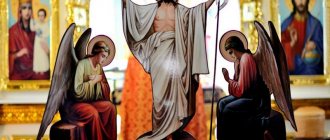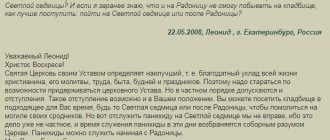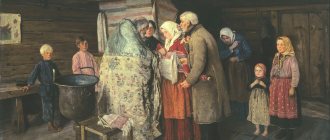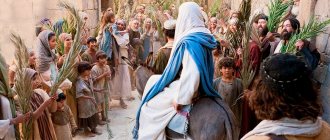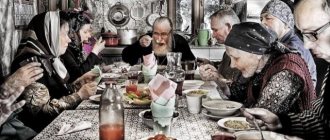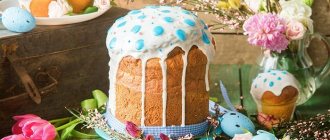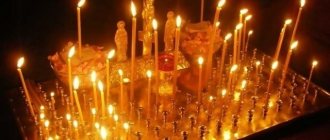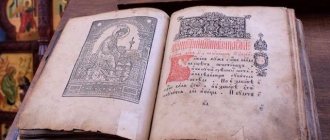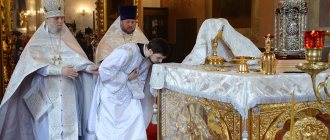BRIGHT WEEK
Bright Week is the first seven days of the celebration of Holy Easter - from Easter proper to the Week of St. Thomas. During Bright Week, fasting on Wednesday and Friday and bowing to the ground are canceled. Morning and evening prayers are replaced by the singing of the Easter hours.
Every day after the Liturgy, a festive procession of the cross takes place, and all bells are rung every day throughout the week.
On Bright Tuesday, a celebration is held in honor of the Iveron Icon of the Mother of God. The icon, located on Mount Athos, became famous for many miracles. In the 17th century, rumors about the miraculous image spread throughout Russia through pilgrims; at the request of the future Patriarch Nikon, a copy of the icon arrived in Moscow.
On Bright Friday, the icon of the Mother of God “Life-Giving Spring” is celebrated. After the Liturgy, according to custom, there is a small blessing of water.
On Bright Saturday, at the Liturgy, a prayer is read for the fragmentation of the artos, and after the service it is distributed to the faithful.
The first Sunday after Easter is called Antipascha and recalls how the Lord Jesus Christ, appearing to the eleven disciples on the eighth day after the Resurrection, renewed His appearance. On this day we also remember the assurance of the Apostle Thomas, why it is called St. Thomas Week or St. Thomas Sunday.
The eight days of celebrating Christ's Resurrection are like one day belonging to eternity, where “time will be no more” (Rev. 10:6).
Starting from the day of Easter until it is celebrated (on the fortieth day), believers greet each other with the Easter greeting “Christ is Risen!”, “Truly He is Risen!”.
Since apostolic times, the holiday of Christian Easter lasts seven days, that is, the entire week, from Easter proper to St. Thomas Week. This week is called “Bright Easter Week”. Each day of the week is also called bright - Bright Monday, Bright Tuesday, etc., and the last day is Bright Saturday. On Easter Week, church services are held daily according to the Easter rite. Morning and evening prayers are replaced by the singing of the Easter hours. All week, after the Liturgy, processions of the cross are held near the church, in which the cross of Christ is carried. Throughout the entire week, all bells are rung every day. After each Divine Liturgy, a festive religious procession is held, symbolizing the procession of the myrrh-bearing women to the tomb of Christ. At the Procession of the Cross, worshipers walk with lit candles. The eight days of celebrating Christ's Resurrection are like one day belonging to eternity, where “there will be no more time” (Rev. 10:6). During Bright Week, fasting on Wednesday and Friday and bowing to the ground are canceled. The royal doors in the iconostasis (separating the altar from the main space of the temple) remain open throughout the week as a sign that on these days the invisible, spiritual, Heavenly world seems to be opening up before the believers. The open Royal Doors are an image of the Holy Sepulcher, from which an Angel rolled away the stone. During the whole of Bright Week they do not close even during the communion of the clergy, and only on Saturday before 9 o’clock they will close. There are no weddings or funeral prayers on Bright Week. Funeral services for the dead are performed, but more than half of them consist of Easter hymns.
Happy Monday
According to biblical tradition, on the first day after the resurrection, Jesus appeared to his disciples and for 40 days told them about the Kingdom of Heaven, after which he ascended into heaven. Bright Monday is a Christian holiday in memory of the first day after the resurrection of Christ. According to the Bible, Christ, having risen, appeared unrecognized to two of his disciples, shared with them the journey to the village of Emmaus, not far from Jerusalem, and dinner. “And He went in and stayed with them. And as He reclined with them, He took the bread, blessed it, broke it, and gave it to them. Then their eyes were opened and they recognized Him. But He became invisible to them. And they said to each other: Did not our heart burn within us when He spoke to us on the road and when He explained the Scripture to us? And, rising at that same hour, they returned to Jerusalem and found together the eleven Apostles and those who were with them, who said that the Lord had truly risen and appeared to Simon. And they told about what had happened on the way, and how He was recognized by them in the breaking of bread. While they were talking about this, Jesus Himself stood in the midst of them and said to them, “Peace be with you.” (Luke, 113th chapter, 24: 12–35) The abbot performs Vespers on the first day of Easter, dressed in all sacred clothes. After the evening entrance with the Gospel, the Gospel is read about the appearance of the Risen Jesus Christ to the apostles in the evening on the first day of His Resurrection from the dead (John 20:19-25). The rector reads the Gospel, turning his face to the people.
Bright Tuesday
On Tuesday of Bright Week, the Orthodox Church celebrates the day of the Iveron Icon of the Mother of God. This holiday was established in honor of the discovery of a miraculous image on Mount Athos in the 11th century. The Iveron Icon of the Most Holy Theotokos, the Goalkeeper or Gatekeeper (Greek: Portaitissa) is an Orthodox icon of the Virgin Mary and Child, revered as miraculous, and belongs to the Hodegetria icon painting type. The original is in the Iveron Monastery on Mount Athos, Greece; according to Orthodox tradition, it was written by the Evangelist Luke.
Troparion to the Iveron Icon of the Mother of God.
From Thy holy icon, O Lady Theotokos, healing and healing are given abundantly with faith and love to those who come to her, so visit my weakness, and have mercy on my soul, O Good One, and heal my body with Thy grace, O Most Pure One.
Bright Wednesday
Orthodox Christians, if possible, try to visit churches on all days of this week, where the services of the Holy Resurrection of Christ continue, the altar Royal Doors are open, and Easter processions are held around churches and monasteries. In each altar until Easter Saturday there is bread consecrated during the Easter service - artos, similar to a large prosphora and which will be crushed and distributed to believers on the coming Saturday. On this day, during Orthodox services, a large passage from the Gospel is read, the conclusion of which is the words of the Savior, predicting that the moment will come when the disciples will see the Lord in glory: “Truly, truly, I say to you: from now on you will see the heavens open and the angels of God ascending and descending to the Son of Man."
Do's and Don'ts
During Bright Week, you are not supposed to go to cemeteries and cry for the dead, because they too receive relief during this holiday. People rejoice along with the angels, glorifying Christ's resurrection.
During this week, one must renounce vanity, leave behind worldly worries and anxieties, which, by the way, disappear by themselves. The world is filled with the highest spiritual joy about the risen Lord. Death has been defeated, and there is no place for tears and despondency.
Let no one cry for their sins on this holiday, as St. John Chrysostom said. All sins are forgiven us by Christ's resurrection.
During this period, you should not indulge in other sins : overeating (as often happens after a long fast), drunkenness, swearing, debauchery, quarrels, etc. These holy days must be spent with dignity.
Light Heel
On Friday of Bright Week the memory of the icon of the Mother of God “Life-Giving Spring” is celebrated. On this day, after the Liturgy, the rite of minor consecration of water is performed (a water-blessing prayer before the icon of the Mother of God “Life-Giving Spring”), and if local circumstances allow, a religious procession to reservoirs or water sources. With the water blessed at this prayer service, believers sprinkle their gardens and orchards, calling on the help of the Lord and His Most Pure Mother to provide the harvest. The Akathist to the Most Holy Theotokos in front of the “Life-Giving Source” icon is intended for cell reading. The appearance of this image is associated with a miraculous event - the healing of the blind man by the Mother of God, which occurred in the middle of the 5th century at a source near Constantinople. The warrior Leo Marcellus, who witnessed this mercy of the Mother of God, and later became emperor (455 - 473), erected a temple on the site of the source and called it the “Life-Giving Source,” meaning the miraculous power of the source. Subsequently, this temple was repeatedly rebuilt and decorated. But after the fall of Constantinople it was destroyed. And only in 1834 - 1835. An Orthodox church was again erected over the Life-Giving Spring, which is still in operation to this day.
Honestly
Nobody forgets about Easter. But about Easter week, Bright Week, people talk and write much less often. And - in vain. Bright Week (also called Bright Week, Holy Week) is not just a continuation of Easter, but its almost complete repetition
Artos at the Royal Doors
Bright Week, as the name implies, lasts seven days. This year it falls on the week of May 3-8. Holy Week begins on Easter Sunday itself and continues for the next six days - until the Week of St. Thomas (the second Sunday after Easter or Antipascha. The Greek prefix “anti” in this case is translated as “opposite”). It is considered impossible to express all the joy of the Resurrection of Christ in one Easter day, so Christians celebrate Easter throughout the next week, and then another 32 days until the Ascension.
Artos
In Orthodoxy, on all days of the week, all services (matins, hours, liturgy and vespers) are similar to the services of Easter. Throughout the entire week, the Royal Doors of Orthodox churches are wide open - until Bright Saturday, when after the liturgy the fragmentation and distribution of the artos takes place. Church bread (artos) is consecrated on the first day of Easter, then it is carried daily during the procession around the temple. On Bright Saturday, at the Liturgy, a prayer is read for the fragmentation of the artos, and after the service it is distributed to the faithful.
Since the time of the ancient Apostolic Church, bread has been given great spiritual significance. He symbolized the Body of Christ. This is the institution of Jesus Christ himself. The Gospel of Luke says: “And he took the bread and gave thanks, broke it and gave it to them, saying: “This is My body, which is given for you; do this in remembrance of Me.” The Divine Liturgy itself was called in ancient times the “breaking of bread.”
Let us remember how in the old days peasant families treated bread. The bread was cut carefully and carefully, they also ate it, the crumbs were picked up and poured into the river or given to animals. Since apostolic times, a tradition has been established during a common meal to leave one piece of bread and put it at the head of the table for the Lord. According to legend, the apostles and disciples began to put aside bread for the Virgin Mary at meals, calling it “panagia,” which is translated from Greek as “all-holy” (one of the epithets of the Mother of God). Later, the prosphora itself, from which a piece was taken in honor of the Most Holy Theotokos, began to be called panagia.
Since ancient times and to this day, the rite of offering the panagia has been served in Orthodox monasteries. After the Divine Liturgy, the abbot carried the panagia from the church in a special vessel to the fraternal meal, where it was crushed and eaten by the brethren with a special prayer before the meal.
An echo of this ancient tradition is the Easter tradition of the consecration and fragmentation of the artos.
The word "artos" is translated from Greek as "leavened bread." This is a special large cylindrical prosphora, on the top of which an imprint of the icon of the Resurrection of Christ is made with a special baker's seal. Artos on a special lectern before the start of the Easter all-night vigil is placed on the sole in front of the icon of the Savior on the iconostasis. According to the prayer behind the pulpit of the Liturgy, it is consecrated by the priest, who says a certain prayer and sprinkles the artos with holy water. The prayer also contains the following words: “Almighty God, Lord Almighty! You commanded through Your servant Moses, during the exodus of Israel from Egypt and the liberation of Your people from bitter slavery, to Pharaoh to slaughter a lamb, prefiguring the Lamb who was voluntarily slain for us on the Cross, taking away the sins of the whole world, Your beloved Son, our Lord Jesus Christ, through whom we received liberation and a way out of eternal slavery to the enemy and deliverance from the indestructible bonds of hell. So we, Your servants, in honor and glory, and in remembrance of the glorious resurrection of Your Son, our Lord Jesus Christ, now on this all-bright, and glorious, and saving day of Easter, offering this bread before Your Majesty, we humbly pray to You: look at this bread, bless and sanctify it. Make us, who brought it, and kiss it, and eat from it, participants in Your heavenly blessing and remove all illness and disease from us by Your power, giving health to everyone. For You are the source of blessings and healing, the Giver, and we send up glory to You, the Beginning Father, with Your Only Begotten Son, and Your Most Holy and Good Life-Giving Spirit, now and always, and unto the ages of ages.”
That is, we bring artos as a gift to God as a symbol of the Bright Resurrection of Christ. And its consecration at the most important service of the year, when the heavens themselves are open, when the Savior is among us, and the heavenly Church unites with the earthly Church in a single Easter praise to the Lord for the redemption and healing of mankind, tells us that artos is great shrine associated with the Resurrection of Christ. Therefore, you need to treat it very reverently and carefully.
Confirmation that the artos is a great shrine is also the fact that it is worn during the religious procession around the temple throughout Bright Week. Throughout Bright Week, the artos remains in a place of honor in the temple in the open Royal Doors.
Artos is a great shrine. Why keep it and eat it? This is evidenced by the words of the prayer for the fragmentation of the artos: “may all who taste from it bodily and mental blessings and health be honored with the grace and generosity of Your philanthropy.” Artos is given for physical and mental health. Therefore, it is useful to eat it during illness or special sorrows in life. He becomes a participant in the eternal Easter joy, a joy that heals the soul and body of a person.
Artos should be kept at home near holy icons. Since this is a great shrine, it is advisable before the service on Saturday of Bright Week to stock up on a bag (preferably linen made from organic fabric), where you should put the resulting piece of crushed artos, so as not to drop the crumbs of the shrine. It is advisable to break up the artos into small pieces: this will make it more convenient for you to consume them. Artos can be distributed, but before that you must make sure that it gets to pious believers. This shrine is eaten with the usual prayer for holy water and prosphora with the addition of “Christ is Risen! Truly He is Risen!”
"From Holy Day to New Week..."
Open Royal Doors
A feature of Easter liturgies is the open Royal Doors (separating the altar from the rest of the church), which symbolize the Spiritual World and the Holy Sepulcher. The gates to the Week remain open until the ninth hour of Saturday evening (that is, until the start of the evening service).
The decision to celebrate Bright Week was made at the Sixth Ecumenical Council (also called the Third of Constantinople). It became the longest of all the councils: it opened on November 7, 680, and ended on September 16, 681. The number of participants in the cathedral increased all the time. At the first meeting there were 43 people present, at the last 163 (among them legates of the Pope), and 240 participants were present when drawing up the rules. The emperor himself was present at the first 11 meetings and at the last, where he signed the council protocols with the wording “read and approved.”
The 66th canon of the Sixth Ecumenical Council decrees: “From the holy day of the resurrection of our Christ Bosch until the new week (that is, until St. Thomas Week), throughout the entire week, the faithful must in the holy churches unceasingly practice psalms and hymns and spiritual songs, rejoicing and triumphing in Christ, and listening to the reading of the Divine Scriptures, and enjoying the holy mysteries. For in this way we will be resurrected together with Christ and ascended. For this reason, on the said days there should not be horse riding or any other folk spectacle.
The week (week) is continuous. There is no fasting on Wednesday and Friday, and even those preparing for Communion cannot voluntarily impose fasting on themselves.”
In Orthodoxy, throughout Holy Week, after the service, religious processions are held, at which believers sing festive chants and the priest sprinkles everyone with holy water. During the religious procession, the festive bell rings. Many churches on Bright Week allow everyone to ring the bells at the belfry, so the ringing of bells often fills the entire area from morning to evening.
During this period, Orthodox Christians read Easter hours instead of both morning and evening prayers. The Easter Hours are a repeatedly sung part of the Easter Orthodox service, replacing the First Hour, Third Hour, Sixth Hour, Ninth Hour, Compline, Midnight Office, Morning Prayers and Evening Prayers during the Easter week. Unlike ordinary hours (church services), the Easter hours never change and do not contain psalms or prayers of repentance (except for “Lord have mercy”). Like all Easter rites, the Easter hours are filled with joy and thanksgiving to Christ our God.
Another feature of the holiday week is the abolition of one-day obligatory fasts on Wednesday and Friday. Also, until the holiday of Trinity, believers are not allowed to bow to the ground. Why? The church charter has its own rules, which all clergy adhere to. They should also be observed by parishioners in the church, but making any mistakes here is not a great sin. After Easter, there comes a period until Trinity, when no prostrations are made in the church. That is, when you need to kneel and touch your forehead to the floor. This is a kind of relaxation for believers who constantly performed such bows during fasting. The Resurrection of the Lord delivers people who came to him from low worship.
Prostration is a manifestation of a believer’s love for God. It is difficult to imagine a different reaction of a person if Christ himself appeared before him. But Jesus’ love is also limitless, which is why Christians have a relaxation in the church charter. But, despite this, every believer can, based on his feelings, bow. There are no strict prohibitions in this regard.
Prostrations to the ground are canceled not only from Easter to Trinity. They are not made from the Nativity of Christ until Epiphany, on the days of the major church feasts. A person is freed from them until the evening if he took communion in the morning. They do not prostrate on Sundays either. But it is allowed to perform them three times, when the holy gifts are brought out, and when their chalice with gifts is removed after Communion, and also at the words “Holy to Holies.”
In addition to prostrations, there is also bowing of the head - this means simply bowing your head slightly, without the sign of the cross. There is a prolonged bowing of the head at certain words during the liturgy. Finally, there is a bow from the waist - before such a bow the sign of the cross is made. It is performed on certain words in prayers and chants.
Life-giving spring
Divine services on Bright Week are performed according to the Easter rite - instead of morning and evening prayers
Easter hours are sung. After the completion of each liturgy, a religious procession is held in honor of the procession of the myrrh-bearing women to the Holy Sepulcher. During the procession, believers carry lit church candles.
Bright Monday in Rus' was called Watering Day. People went to visit and doused themselves with a bucket, washing away diseases.
On Tuesday they honor the Iveron Icon of the Mother of God. The icon, located on Mount Athos, became famous for many miracles. In the 17th century, rumors about the miraculous image spread throughout Russia through pilgrims; at the request of the future Patriarch Nikon, a copy of the icon arrived in Moscow. In the old days, this day was called Bathing Day. Those who slept through matins were doused with water. The people organized festivities and various entertainments.
On Hail Wednesday it was forbidden to work in the garden, otherwise the crop could be destroyed by hail.
Thursday was called the Easter of the Dead. They remembered the departed, but lightly, without expressing grief, but rejoicing at the resurrection of Christ.
On Friday, the icon of the Mother of God “Life-Giving Spring” is venerated. According to tradition, on this day, after the Divine Liturgy, the water is blessed, and if local weather conditions allow, a procession of the cross is made to reservoirs and springs. In the old days it was called Forgiveness Friday in honor of the reconciliation of a mother-in-law with her son-in-law.
...Forgiveness Friday, Gradova Wednesday, Bathing Suit... There is no need to see any echoes of paganism in these folk traditions. It is no coincidence that the Russian Orthodox Church itself did not see anything “heretical” in such traditions, and did not make any attempts to “burn out” these folk traditions. Perhaps this is precisely why the Christian faith was so strong in Rus', because no one demanded that ordinary people forget forever the history of their ancient ancestors? But we can tell you in more detail about the history of the Life-Giving Spring icon.
In the 5th century, not far from Constantinople, there was a grove of plane trees and cypresses dedicated to the Blessed Virgin Mary, in the middle of which there was a spring. However, no one took care of the grove, and the place gradually became overgrown, and the source became clogged. One day, the warrior Leo Marcellus, a kind and humble man, helping a lost blind man onto the path, found himself in this place. The blind old man felt very thirsty and began to beg the warrior to give him something to drink. The lion searched for water for a long time, but in vain, and suddenly heard a voice: “Don’t be discouraged, O King Leo, the water you are looking for is close, just turn to it. Build a temple for Me in this place: in it I will listen to prayers and give what I want to everyone who comes here with zeal and faith. Nothing will strongly resist My power: a demon, an incurable disease, or anything else, as long as they ask Me reverently.” Leo looked around, but could not see the source, and found it only thanks to the instructions of the mysterious voice. He gave the blind man some water to drink and put mud from the spring on his eyes, after which the old man regained his sight. And then Leo knew who had spoken to him.
Having become, according to the prediction of the Blessed Virgin, emperor in 457, Leo Marcellus ordered the spring to be cleansed and erected over it a magnificent temple dedicated to the Mother of God, which he called the “Life-Giving Spring.” In the huge gilded dome of the temple, holes were made through which the rays of the sun illuminated the source lined with white marble and, reflecting from the marble walls and the vault decorated with gold, shone like lightning.
Two marble staircases of 25 steps led to the source, located in the middle of the temple. The dome contained a mosaic image of the Mother of God and Child, which was reflected in the source. At the top of the source there was a round depression in the marble into which water from the source flowed, and then it poured into the marble pool, so that it was convenient to draw it from all sides. At the same time, an image was painted depicting the structure of the temple and its gracious essence.
Almost a hundred years after the first miracle at the Life-Giving Spring, Emperor Justinian, suffering from a serious illness, in a dream heard the voice of the Mother of God, who commanded him to go to Her source. Having fulfilled his command, he found healing here. In gratitude to the Mother of God, he rebuilt the temple at the Life-Giving Spring and richly decorated it, and here he built a monastery for monks. This was in the 6th century.
In the second half of the 9th and early 10th centuries, the temple was carefully restored and decorated under the emperors Basil the Macedonian and his son Leo the Philosopher, who also received healing from the source; in addition, his first wife Theophanes and brother Stephen were healed of various diseases here.
Queen Zoe, whom he married after the death of Theophanes, was healed of infertility after the girdle of the Most Holy Theotokos was placed on her and became the mother of Constantine Porphyrogenitus.
In the 15th century, the temple of the “Life-Giving Spring” was destroyed by Muslims. A Turkish guard was assigned to the ruins, who did not allow anyone to approach this place. Gradually, the severity of the ban softened, and Christians built a small church there. But it was also destroyed in 1821, and the source was filled up. The Christians again cleared the ruins, opened the spring and continued to draw water from it. Sultan Bayazid was tired of this, and he personally decided to desecrate the source of the Virgin Mary, for which he threw half-rotten goldfish that died in his pool into the sacred water. To his horror, the fish came to life in the water! The shocked Sultan in 1830 allowed Christians to use the Life-Giving Spring again and even allocated money for the construction of the temple.
Subsequently, in one window, among the rubble, a sheet half-rotten from time and dampness was found with a record of ten miracles from the Life-Giving Source that occurred from 1824 to 1829. For example, the case of the resurrection of the dead is described. One seriously ill man named Fettal sailed here by ship from the city of Thessaly specifically to pray for healing, but died on the way to the source. However, before his death, he bequeathed to his companions to take his body to the temple at the Life-Giving Spring and pour water from the spring over it three times, and then bury it. When they began to pour water from the miraculous spring on the deceased, he came to life and then remained until the end of his days as a monk in the monastery at the temple. His coffin was found in 1830 during excavations to restore an ancient church, which was destroyed by the Turks during the capture of Constantinople in the 15th century.
Under Sultan Mahmud, the Orthodox received some freedom in performing divine services. They used it to build a temple over the Life-Giving Spring for the third time. In 1835, with great triumph, Patriarch Constantine, concelebrated by 20 bishops, consecrated the temple; A hospital and almshouse were set up at the temple. Gradually, a monastery was formed around the temple of the Life-Giving Spring, and the area received the name Balykly, which means “red fish” in Turkish. There is a folk legend that the fish that were once found in the font of the Life-Giving Spring were unusually red.
The Synaxarion also describes the miracle of the appearance of the Mother of God to save those praying in the temple from an earthquake. The Queen of Heaven supported the temple until all the people left it and no one was hurt.
In Rus', the icon has been known and revered since ancient times. Starting from the 16th century, the custom of dedicating springs located in monasteries to the icon of the Mother of God “Life-Giving Spring” became established. After the liturgy, according to custom, there is a small blessing of water.
A week is like one day, and one day is like a year
On Saturday - the day of St. Artos - church bread is solemnly crushed and distributed to parishioners. Believers, as we have already said, should keep it as a shrine all year, pinching off pieces on an empty stomach, and especially when they are sick.
Sunday is called St. Thomas's Day or Krasnaya Gorka; believers celebrate Antipascha. On this day, the Church remembers the Apostle Thomas, who doubted the resurrection of Christ. It was on this day that the Savior appeared to the disciples, including Thomas, and showed his wounds to convince them of his resurrection. On Fomino Sunday, brides are shown (matchmaking) and weddings take place.
On Easter week it is customary to rejoice at the divine resurrection of Christ. Believers pray intensely, visit churches every day, and ring church bells. You need to think about the bright and good, help the poor and needy, as well as relax and enjoy the life given by God.
Throughout Easter week and before it is celebrated (on the fortieth day), believers greet each other with the words: “Christ is risen! He is truly risen!”
The entire holiday week is dedicated to bright feelings and positive emotions. You can’t quarrel with loved ones, get angry and swear. There should be no sadness or negativity in your soul. Joy, fun, solemn and complacent expressions of feelings are encouraged. There is no need to think about suffering, illness, death, or remember those who have passed away with bitterness.
The eight days of celebrating Christ's Resurrection are like one day belonging to eternity, where “time will be no more” (Rev. 10:6).
As for everyday life, it is not recommended to work or visit the cemetery throughout the week. You cannot fast or hold funerals. Spouses should refrain from intimacy, all thoughts should be aimed at receiving and expressing spiritual joy. There are no other restrictions at this time.
These days after Lent, the “week of abundance” begins, when the tables are full of fatty foods, pastries and sweets. It is advisable not to overeat, but to gradually enter a normal regime, otherwise exacerbations of diseases of the digestive tract are inevitable. On Easter, a person must understand the meaning of life - gain after loss, the triumph of life over death.
There are no weddings or funeral services during Weekend. The presence of the deceased in the temple is accompanied by Easter chants instead of traditional funeral prayers.
During the Week in churches, instead of morning and evening prayers, the Easter Hours are read, separating Easter Matins from the Liturgy. They are not read, as usual, but sung, and they do not consist of psalms, but of selected Easter hymns, easily recognizable by ear. All hours: 1st, 3rd, 6th, 9th are exactly the same and read the same way.
The most famous Easter service, of course, is “Christ is risen from the dead, trampling down death by death, and giving life to those in the tombs” (“ Christ is risen from the dead, trampling on death through death, and giving life to those in the tombs ”). These words are sung three times during each Easter hour.
“Having seen the Resurrection of Christ, let us worship the holy Lord Jesus, the only sinless one. We worship Thy Cross, O Christ, and we sing and glorify Thy holy resurrection: For Thou art our God, do we know no other unto Thee, we call Thy name" (“Having seen the Resurrection of Christ, let us worship the Holy Lord Jesus, the only sinless one. We worship Thy Cross, O Christ, and we glorify and glorify Your Holy Resurrection, for You are our God, we know no other but You, we call on Your name ”), says the other Hours.
Also, the words are heard three times during the services of Bright Week: “Come, all you faithful, let us worship the Holy Resurrection of Christ: behold, joy has come through the Cross to the whole world. Always blessing the Lord, we sing His resurrection: having endured the crucifixion, destroy death by death" (“ Come, all faithful (Christians), let us worship the holy resurrection of Christ, for behold, joy has come through the Cross to the whole world. Always blessing the Lord, we sing of His resurrection, for Having endured crucifixion, he crushed death through death ."
We all still have many joyful Easter days ahead of us. The joy of the Resurrection of Christ will be in us not only 40 days before Trinity. For the rest of the year, Easter joy remains in people. And it turns out that Easter joy lives in us year after year - all our lives. It is impossible to wish for anything better for a Christian. God is Love. Love is joy. Living with joy in your soul - could there be anything better?
Click to support "Honestly"
Share
Bright Saturday
Throughout Bright Week, a special bread called artos stands near the open Royal Doors. This custom has been established since apostolic times. It is known that after His resurrection the Lord repeatedly appeared to His disciples. At the same time, He either ate the food Himself or blessed the meal. In anticipation of these blessed visits, and later in memory of them, the holy apostles left the middle place at the table unoccupied and placed part of the bread in front of this place, as if the Lord Himself was invisibly present here. In continuation of this tradition, the Fathers of the Church established the placing of bread in the church on the Feast of the Resurrection of the Lord. On Saturday of Bright Week after the Divine Liturgy, the art is solemnly blessed and a special prayer is read for the fragmentation of the artos. After this, pieces of this sacred bread are distributed to the believers. Then this shrine is given to the sick or to those who cannot be admitted to Holy Communion. Those praying, having received part of the artos after the end of the Liturgy, keep it throughout the year (usually by cutting it into small pieces and eating them on an empty stomach, especially during illness). On Saturday of Bright Week, for the first time after Easter, the Royal Doors in churches are closed.
Anti-Easter. Fomino Sunday
On the eighth day after Easter, as the end of Bright Week, there follows a special celebration called Antipascha, which means “instead of Easter” or the second Easter. On the eighth day, the Holy Church also remembers the appearance of the Risen Lord to the Apostle Thomas, who refused to believe in the Resurrection of Christ. On this day, the Lord again appeared to His disciples, especially to the Apostle Thomas, to convince him with His wounds that it was with Him that all the witnesses of His Resurrection met. The first Sunday after Easter in the church calendar is called Antipascha or St. Thomas Sunday. People call this day Red Hill. The name Antipascha means “instead of Easter” or “opposite of Easter” - but this is not opposition, but an appeal to the past holiday, repeating it on the eighth day after Easter. Since ancient times, the end of Bright Week has been celebrated especially, constituting a kind of replacement for Easter. This day is also called St. Thomas Week, in memory of the miracle of the assurance of the Apostle Thomas. The death of Christ on the cross made an incredibly depressing impression on the Apostle Thomas: he seemed to be confirmed in the conviction that His loss was irrevocable. To the disciples’ assurances about the resurrection of Christ, he replies: “Unless I see in His hands the marks of the nails and put my hand into His side, I will not believe” (John 20:25). On the eighth day after the Resurrection, the Lord appeared to the Apostle Thomas and, testifying that he was with the disciples all the time after the Resurrection, did not wait for Thomas’s questions, showing him His wounds, answering his unspoken request. The Gospel does not say whether Thomas really felt the wounds of the Lord, but faith kindled in him with a bright flame, and he exclaimed: “My Lord and my God!” With these words, Thomas confessed not only faith in the Resurrection of Christ, but also faith in His Divinity. According to Church Tradition, Saint Thomas the Apostle founded Christian Churches in Palestine, Mesopotamia, Parthia, Ethiopia and India, sealing the preaching of the Gospel with martyrdom. For the conversion of the son and wife of the ruler of the Indian city of Meliapora (Melipura) to Christ, he was imprisoned, endured torture and, finally, pierced with five spears, went to the Lord. Starting from St. Thomas Sunday in the Orthodox Church, after a long Lenten break, the sacrament of weddings is resumed. In Rus', it was on this day, Red Hill, that the most weddings took place, festivities and matchmaking were held.
Nevsky Thursday or Easter of the Dead
Among the pagans there was a strong belief in the return of souls. It underwent transformations with the advent of Christianity, but retained its strength. Therefore, no one went to church on Wednesday night. It was believed that there was a service for the dead there and that the living were in danger at such an hour.
Russians have a custom of drawing a large cross on the grave and rolling red eggs on it, glorifying the Resurrection of Christ. Through the years, Ukrainians carried the belief about Rahmans living underground. They don't see the sun, so they can't determine when Easter will come. To inform them about the joyful event, people throw colored shells into the river.
In the Voronezh province the custom of “leading a mare” is still alive. The head of a papier-mâché horse is placed on the pole, the tail is tied to the other end, and covered with an improvised “blanket”. A man dressed as a gypsy walked around the village with a dressed-up stick, offering rides to everyone. Modern Orthodox Slavs celebrate the day of remembrance of the dead on the last day of Maslenitsa - Forgiveness Sunday or on Krasnaya Gorka.
Easter Period
Concluding the bright celebration of Easter with the week, the Church continues it, although with less solemnity, for another thirty-two days - until the Ascension of the Lord. This entire period (40 days after Easter) is considered the Easter period, and Orthodox Christians greet each other with the greeting “Christ is Risen!” and the answer “Truly He is Risen!” From the first day of Easter until Vespers on the feast of St. Trinity genuflections and prostrations are not allowed. Before the Feast of the Holy Trinity (on the fiftieth day after Easter), prostrations are not performed. Easter hymns are sung in church until the Feast of the Ascension of the Lord, which is celebrated on the fortieth day after the first day of Easter.
Does the canons say anything about Bright Week?
Rule 66 of the Sixth Ecumenical Council decrees: “From the holy day of the resurrection of Christ our God until the new week [that is, until St. Thomas Week], throughout the entire week, the faithful must in the holy churches unceasingly practice psalms and hymns and spiritual songs, rejoicing and triumphant in Christ, and listening to the reading of the Divine Scriptures, and enjoying the Holy Mysteries. For in this way we will be resurrected together with Christ and ascended. For this reason, on the said days, there should not be horse riding or any other folk spectacle.”
Why does the Church sanctify Easter cakes and Easter cakes?
Christian Easter is Christ Himself with His Body and Blood. “Easter Christ the deliverer,” as the Church sings and the Apostle Paul says (1 Cor. 5:7). Therefore, one should especially receive communion on Easter day. But since many Orthodox Christians have the custom of receiving the Holy Mysteries during Great Lent and on the bright day of the Resurrection of Christ, only a few receive communion, then, after the Liturgy is celebrated, on this day special offerings of believers, usually called Easter and Easter cakes, are blessed and consecrated in the church, so that they can eat from them it reminded of the communion of the true Pascha of Christ and united all the faithful in Jesus Christ. The consumption of blessed Easter cakes and Easter cakes on Holy Week by Orthodox Christians can be likened to the eating of the Old Testament Passover, which on the first day of Easter week God's chosen people ate as a family (Exodus 12:3-4). Also, after the blessing and consecration of Christian Easter cakes and Easter cakes, believers on the first day of the holiday, having come home from churches and having finished the feat of fasting, as a sign of joyful unity, the whole family begins bodily reinforcement - stopping the fast, everyone eats the blessed Easter cakes and Easter, using them in throughout Bright Week.
Sources: 1. Prot. S. Slobodsky “The Law of God” M.: Yauza-press, Lepta Book, Eksmo, 2008. 2. Websites: https://ru.wikipedia.org/wiki https://azbyka.ru/dictionary/17/svetlaya_sedmitsa. shtml https://ria.ru/religion/
What can you eat on Bright Week after Easter?
At this time, it is better to have time to confess and take communion; breaking the fast is considered an optional attribute of the Easter fast. Lay people observing Lent can eat whatever they want during this period: traditional Easter cakes (butter cakes), Easter cottage cheese, chicken eggs, meat, fish and other products. There are no dietary restrictions during this time.
But parishioners should take into account that the clergy of churches advise observing moderation in everything and not turning this happy time into a continuous celebration. The consumption of alcoholic beverages these days should be, if not excluded, then radically limited. You shouldn’t deny yourself fun and entertainment, but there should be moderation in everything.
